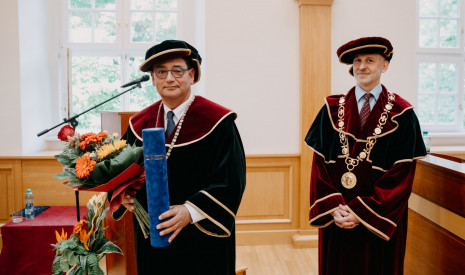University of Trnava (Slovakia) Health in man is like salt, which gives taste to food

The Scientific Board of the University of Trnava in Trnava discussed and approved the proposal of the Rector of the University of Trnava in Trnava, prof. PaedDr. René Bílik, CSc., for the awarding of the honorary title of DOCTOR HONORIS CAUSA OF THE UNIVERSITY OF TRNAVA IN TRNAVA, to an exceptional and internationally recognized personality, prof. Béla MERKLEY, MD, Ph.D., MSc, FESC, FACC, for his lifelong work and significant international contribution to scientific knowledge and education in medical sciences.
The proposal was discussed and approved by the Scientific Board of Trnava University in Trnava at its meeting on April 7, 2022. The honorary doctorate was awarded to prof. B. Merkely at the end of the academic year on Wednesday, May 11, 2022. Read the speech of the renowned cardiologist and Rector of the partner Semmelweis University.
Ceremony speech by Béla Merkely at the award of Doctor Honoris
causa by Trnava University in Trnava
“Health in man is like salt, which gives taste to food: because who has
no health, cannot savour any pleasure or delight.”
On the anniversary celebration, let me offer you the reflections
of Péter Pázmány. The person of Cardinal Pázmány, founder
of the former University of Trnava, is a close link between our institutions.
And the quote I chose illustrates perfectly how exceptional
the field of health sciences is, which is also a common intersection for
Semmelweis University and Trnava University.
Péter Pázmány considered the foundation of the University of Trnava in 1635 as his greatest accomplishment. The organisation
of medical training at the institution began in 1769, after Queen Maria
Theresa issued a decree establishing the Faculty of Medicine. Thus
Semmelweis University, Hungary‘s oldest university of Medicine and
health sciences were founded.
Maria Theresa‘s so-called Intimatum of November 7, 1769, on the
The faculty of Medicine was an integral part of a comprehensive reform
the process at the time, at the imperial level. It was based on the recognition
that health was a primary state interest and, as such, required a
the high degree of involvement. The design of the medical faculty in Trnava
was developed by Gerard van Swieten, the Queen‘s court doctor
with Dutch roots, based on the workings of the Viennese medical
faculty, which he reformed on the model of the Leiden faculty.
Before this, Hungarian doctors could only study at foreign universities
or private schools and surgeons in guilds.
The faculty of medical education began in 1770, initially with
five departments: physiology and pharmacy; anatomy; surgery, botany, and chemistry; and general pathology, so the clinical practice.
A separate building was erected for the new faculty, designed by Franz
Anton Hillebrandt is considered one of the most famous Austrian architects
of the time of Maria Theresa and Joseph II. However, the lack of
an own clinic caused a severe problem in pathology education. The
university moved to Buda in 1777 and then to Pest shortly afterward,
which was meant to resolve the issue.
In recent years, Semmelweis University celebrated the 250th anniversary
of its foundation and its 250th academic year. Today, the institution
is the leading medical and health sciences institution in Hungary
and the Central European region, ranking higher and higher in the
world rankings every year. We are currently in the top 300, but our goal
is to be among the world‘s TOP 100 universities and the top 5
medical universities in Europe.
Our historical roots – to which we recently paid tribute with a series of
cross-border celebrations – are not forgotten for a moment. Our university has been made great by a series of personalities. It
is no coincidence that two of the most prominent seats in our Senate
Chamber is adorned with paintings of Peter Pázmány and Maria Theresa
– we make critical decisions for the future under their watchful
eyes. And at our opening ceremonies, our students take the oath on a
sceptre made in 1772 for the Faculty of Medicine of the University of
Trnava.
Today, we stand here as proud descendants who have handled the
legacy well. The University of Trnava is the predecessor of three Hungarian
universities, including Semmelweis University, Eötvös Loránd
University and Pázmány Péter Catholic University, all at the forefront
of their fields. Trnava University, which was re-established in 1992 and
is now celebrating its 30th anniversary, has also, like its great predecessor,
gained prestige and respect in the academic world in Slovakia
and abroad very quickly, and is one of the highest-quality educational
institutions.
It is a pleasure and an honor for me to have been able to sign a Memorandum
of Cooperation with Rector Prof. René Bílik a few months ago.
That will provide the basis for further cooperation. This concerns research, student and faculty exchanges, joint conferences, symposia, and seminars. Such international collaborations are significant as they are the main drivers of knowledge transfer and scientific
progress. And it has a particular significance when an agreement
is concluded between institutions with a shared history going
back centuries!
Also, in the context of our historical ties, the title of Doctor Honoris
Causa conferred on me, which I am particularly pleased to receive on
the occasion of the 30th anniversary of the University of Trnava. I am
proud of both our common roots and our growing collaborations that
link Trnava University and Semmelweis University, in the past and in
the future.
